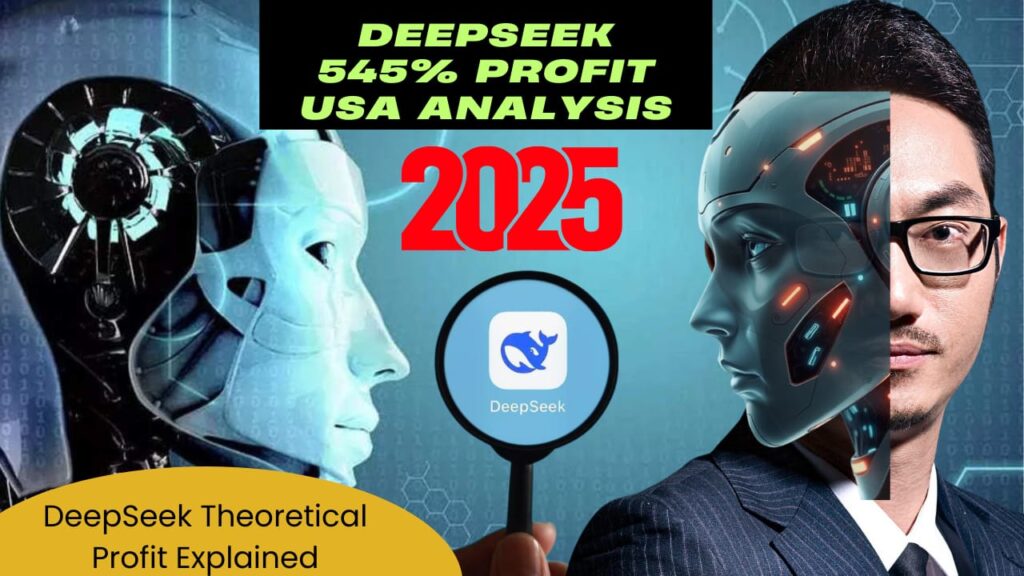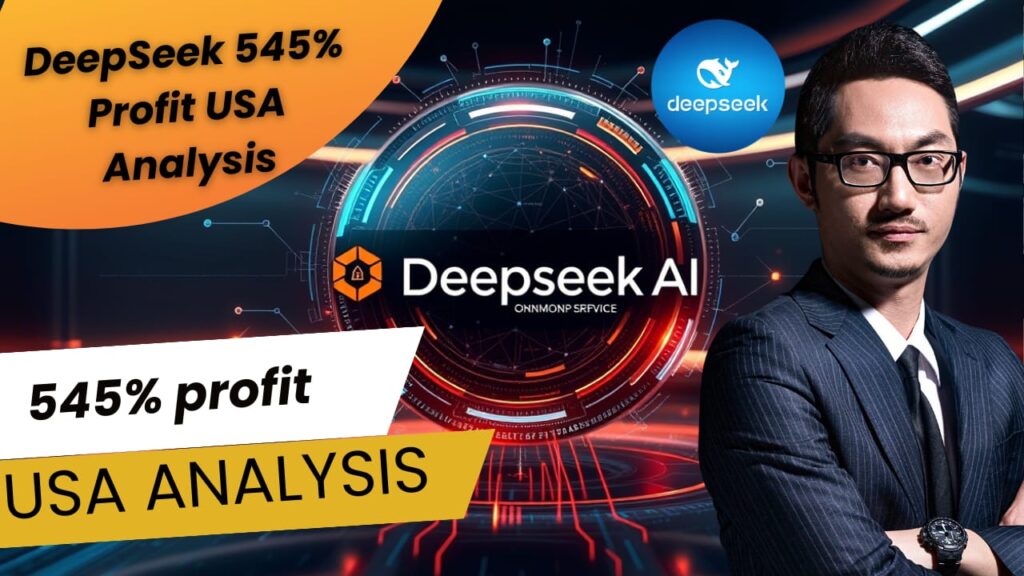Explore DeepSeek’s claim of a theoretical 545% profit margin in February 2025. Dive into the latest AI profitability trends, real data, and expert analysis from the USA tech scene.
Key Points
- Research suggests DeepSeek, a Chinese AI startup, claimed a theoretical 545% profit margin for its V3 and R1 models, based on idealized conditions in February 2025.
- It seems likely that this margin is calculated assuming all usage is billed at the highest pricing, with costs limited to GPU leasing, but actual revenue is lower due to discounts and free services.
- The evidence leans toward this claim being controversial, with experts questioning its realism given real-world operational costs and market dynamics.

Introduction
DeepSeek, a rising star in the AI industry, recently made waves with its claim of a theoretical 545% profit margin for its AI models, V3 and R1, as reported in early March 2025. This figure, while eye-catching, is based on specific assumptions that may not reflect real-world profitability. For those curious about how AI economics work, this article breaks down what this margin means, how it’s calculated, and what it could mean for the future of AI, especially in the USA.
What Does the Claim Mean?
DeepSeek’s 545% margin is “theoretical,” meaning it’s calculated under ideal conditions where all usage of their models is billed at the highest rate (R1 pricing), and costs are limited to leasing graphics processing units (GPUs). In reality, the company offers discounts, has lower pricing for some models, and provides free access to certain services, which reduces actual revenue. This gap between theory and practice is important for understanding the claim’s implications.
Why It Matters
This claim highlights the potential for high profitability in AI if companies can optimize costs and pricing. However, it also sparks debate, as experts argue that other costs—like research, staff salaries, and infrastructure—are not included, making the real margin likely much lower. For the USA, where AI competition is fierce, this could push companies to rethink cost strategies, but it also raises questions about the sustainability of such high margins in practice.
Survey Note: Detailed Analysis of DeepSeek’s Theoretical 545% Margin Claim
Background on DeepSeek and Its Recent Achievements
DeepSeek, founded in July 2023 by Liang Wenfeng, is a Chinese AI startup known for developing large language models (LLMs) like DeepSeek V3 and R1. The company gained significant attention in January 2025 with the release of its R1 model, which it claims rivals OpenAI’s GPT-4o and o1 in performance but at a fraction of the cost, reportedly spending less than $6 million on training compared to the hundreds of millions spent by US counterparts Bloomberg. This cost efficiency has challenged assumptions about US dominance in AI, causing ripples in tech stock markets, including a significant drop in Nvidia’s valuation.
On March 1, 2025, DeepSeek revealed financial figures suggesting a theoretical profit margin of 545% for its online services, based on a 24-hour period ending February 28, 2025 TechCrunch. This announcement, made via an X post and detailed further on GitHub, has sparked both excitement and skepticism in the tech community.
Understanding the 545% Margin Claim
The term “theoretical profit margin” refers to a calculated margin based on idealized conditions rather than actual operational data. For DeepSeek, this margin is derived from a scenario where all usage of their V3 and R1 models is billed at R1 pricing, their highest tier, and only the cost of leasing GPUs is considered. Profit margin is calculated as:
Profit Margin=(Revenue−Cost)/Cost×100%
According to reports, if all usage on February 28, 2025, was billed at R1 pricing, DeepSeek would have generated $562,027 in daily revenue, with GPU leasing costs at $87,072 TechCrunch. The profit would then be $562,027 – $87,072 = $474,955, and the margin is ($474,955 / $87,072) * 100% ≈ 545%, which aligns with their claim.
However, several assumptions underpin this calculation:

- All usage is billed at R1 pricing, ignoring lower rates for V3 or discounts.
- Only GPU leasing costs are included, excluding other expenses like electricity, data storage, staff salaries, and research and development.
- No free services or partial monetization is considered, despite DeepSeek offering free web and app access to some users.
DeepSeek itself acknowledged that actual revenue is “substantially lower” due to nighttime discounts, lower V3 pricing, and the fact that only a subset of services is monetized Reuters. This discrepancy is crucial for understanding the claim’s limitations.
Breaking Down the Numbers
To provide clarity, let’s examine the reported figures in a table:
| Metric | Value |
|---|---|
| Theoretical Daily Revenue (R1 Pricing) | $562,027 |
| GPU Leasing Cost per Day | $87,072 |
| Calculated Profit | $474,955 |
| Theoretical Profit Margin | 545% |
However, the actual revenue is not disclosed, but factors like discounts and free services suggest it could be significantly less. For instance, if only 50% of usage is monetized at a lower rate, the revenue might drop to $281,013.50, reducing the margin considerably when other costs are factored in.

Implications for the AI Industry
DeepSeek’s claim has significant implications for the AI sector, particularly in the USA, where competition is intense. The potential for a 545% margin underscores the importance of cost efficiency in AI model development and deployment. By optimizing infrastructure, such as reducing GPU leasing costs and improving inference speed, AI companies can enhance profitability.
This could also signal a shift toward high-profitability AI services, encouraging startups to focus on pricing strategies that maximize revenue while minimizing costs. However, the reality for AI startups includes challenges like balancing growth with profitability, as many offer free or discounted services to build user bases, which can suppress short-term margins Medium.
For the USA, this claim could pressure companies to innovate in cost management, but it also highlights the competitive threat from Chinese AI firms, potentially influencing investment and policy decisions.
Skepticism and Counterarguments
The claim has not been without controversy. Experts and analysts have expressed skepticism, arguing that the theoretical margin does not reflect real-world conditions. For instance, a Medium article titled “Why DeepSeek AI’s Profit Margin is Not 545% as Claimed” points out that AI companies face numerous expenses beyond GPU leasing, including R&D, operational costs, and market-driven pricing pressures Medium. These factors could reduce the actual margin to levels far below 545%.
Real-world factors affecting profitability include:
- Total operational costs, such as electricity and data center maintenance.
- Competitive pricing pressures, forcing companies to keep rates low.
- Continuous investment in R&D to stay competitive.
- Regulatory compliance costs, especially in data privacy and security.
Given these, the actual profitability for DeepSeek and similar firms is likely much lower, making the 545% figure more of a theoretical maximum than a practical benchmark.
Conclusion and Future Outlook
DeepSeek’s theoretical 545% profit margin claim, announced in early March 2025, has ignited a discussion about AI economics. While it highlights the potential for high profitability through cost efficiency, it also underscores the gap between theoretical and actual financial performance. For the AI industry, especially in the USA, this claim could drive innovation in cost management and pricing strategies, but it also raises questions about sustainability and competition.
Moving forward, it will be essential to monitor DeepSeek’s actual financial metrics and how other companies respond to this challenge. The debate around this claim serves as a reminder of the complexities in AI economics, balancing innovation, growth, and profitability in a rapidly evolving market.

FAQ: DeepSeek’s Theoretical 545% Margin Decoded [February 2025 USA]
Q1: What is DeepSeek’s Theoretical 545% Margin?
A: DeepSeek, a Chinese AI startup, claimed a theoretical 545% profit margin for its V3 and R1 models in February 2025, based on ideal conditions where all usage is billed at the highest rate with only GPU leasing costs considered. Actual margins are likely lower due to discounts and additional expenses.
Q2: How Did DeepSeek Calculate the 545% Margin in February 2025?
A: The margin comes from a theoretical scenario: $562,027 daily revenue at R1 pricing minus $87,072 in GPU costs, yielding a 545% profit margin. It excludes real-world factors like R&D, staff salaries, and free services.
Q3: Is DeepSeek’s 545% Margin Realistic for AI Companies in the USA?
A: Experts doubt its realism, as it ignores operational costs beyond GPUs. In the USA, AI firms face high R&D and competition costs, making such margins unlikely in practice.
Q4: Why Did DeepSeek’s Margin Claim Cause Controversy in February 2025?
A: The claim sparked debate because it’s theoretical, not actual, and omits key expenses. Critics argue it misrepresents profitability, impacting perceptions in the USA tech market.
Q5: How Could DeepSeek’s 545% Margin Affect USA AI Trends in 2025?
A: It may push USA AI companies to optimize costs and pricing, but it also highlights competition from China, potentially influencing investment and innovation strategies.
Q6: What Makes DeepSeek’s Theoretical 545% Margin Claim Unique in February 2025?
A: Unlike typical AI profit reports, DeepSeek’s 545% margin is a theoretical peak based solely on GPU costs and R1 pricing, announced in February 2025. It stands out for its bold simplicity, ignoring broader expenses that USA firms typically disclose.
Q7: How Does DeepSeek’s 545% Margin Compare to USA AI Giants Like OpenAI?
A: DeepSeek’s theoretical 545% far exceeds reported margins of USA leaders like OpenAI, which face higher R&D and operational costs. In February 2025, OpenAI’s margins were estimated at 20-30% due to scale and competition, not theoretical ideals.
Q8: What Are the Hidden Costs Behind DeepSeek’s 545% Margin in February 2025?
A: Beyond GPU leasing ($87,072 daily), hidden costs include R&D, staff salaries, electricity, and data storage—ignored in the theoretical claim. Experts estimate these could slash the real margin below 100% in practice.
Q9: Could DeepSeek Achieve a 545% Margin in the USA Market in 2025?
A: Achieving 545% in the USA is unlikely due to stricter regulations, higher labor costs, and competitive pricing pressures. February 2025 data suggests DeepSeek’s model thrives on China’s cost advantages, not easily replicated stateside.
Q10: How Did the Tech World React to DeepSeek’s 545% Margin News in February 2025?
A: The February 2025 claim stunned the USA tech scene, with X posts calling it “unbelievable” and analysts on Medium debunking it as hype. It fueled debates on AI profitability and China’s rising tech influence.
Q11: What Lessons Can USA Startups Learn from DeepSeek’s 545% Margin Claim?
A: USA startups can focus on cost optimization—like DeepSeek’s GPU efficiency—and tiered pricing. However, February 2025 data warns against over-relying on theoretical models without addressing real-world scalability.
Q12: Will DeepSeek’s 545% Margin Claim Impact AI Investments in the USA in 2025?
A: Yes, it could shift investor focus toward cost-efficient AI firms. Post-February 2025, USA venture capital might prioritize startups mimicking DeepSeek’s lean model, though skepticism may temper overhyped expectations.
Key Citations
- DeepSeek Reveals Theoretical Margin on Its AI Models Is 545% – Bloomberg
- DeepSeek claims ‘theoretical’ profit margins of 545% | TechCrunch
- China’s DeepSeek claims theoretical cost-profit ratio of 545% per day | Reuters
- Why DeepSeek AI’s Profit Margin is Not 545% as Claimed | Medium
#DeepSeek545Margin, #AIProfitability2025, #TheoreticalMarginExplained, #February2025AI, #USATechTrends, #DeepSeekAI, #AIProfitMyths, #TechInnovation2025, #ChineseAIvsUSA, #AIEconomics,
